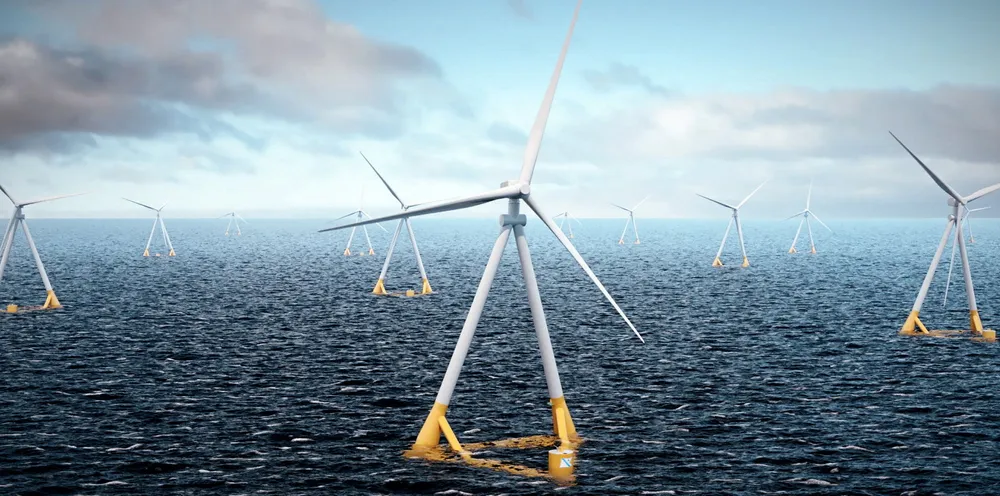Floating wind ramp-up may take longer than expected due to delivery challenge
Key twice-yearly report on progress toward floating wind expansion suggests global ramp-up is being delayed

A closely-watched forecast of installation of floating offshore wind energy capacity has been scaled back for a second time in 12 months due to a sag in the rate of offtake agreements, as well as permitting issues.
A twice-yearly Floating Offshore Wind Report published today (Monday) by energy research specialists TGS | 4C Offshore predicted that 12.4GW of floating wind will commence installation globally by 2030, and 39GW by 2035, which corresponded to a current estimate of 6-7GW operational by 2030 and 3GW by 2035.
These leading forecasts for floating wind capacity that will be operational or under construction globally were down by 1.8GW for 2030 and 6.4GW for 2035 when compared with the same floating wind report released in the final quarter of 2022.
The forecast for operational or under construction capacity was also down 3.7GW and 8.7GW, respectively, from when the report was released one year ago.
The 4C Offshore report stated that the reduced momentum of floating wind installation was partly due to lower-than-expected rates of securing offtake contracts and other delays, resulting in greater volume shifting post-2030.
The report stated: " The decrease reflects a change in analyst confidence, due in part to slow permitting in multiple countries, concerns of supply chain bottlenecks, and the sheer time and resources required to build floating wind farms at the scales proposed."
Some 300MW of floating wind projects had reached the offshore installation phase by mid-2023, the report noted, and highlighted the growing volume of floating tenders in the global market, with 750MW already underway in France and new opportunities expected in 2024 in the UK, Taiwan, Portugal, Spain, USA, and Italy.
However offshore wind research specialist 4C Offshore noted that that the sector is coming into being during a turbulent time due to "increasing costs, regulatory hurdles and policy side anxieties, limited infrastructure, concerns over technological availability, lengthy lead times and pressure to deliver more."
While Japan is expected to revive its floating wind ambitions with a significant tender in 2026, there has also been a slowing in progress in some major markets due to knock on impacts of current tender delays in France and low visibility on the giant second Ulsan phase in South Korea, the report suggested.
TGS | 4C Offshore's Director of Research Richard Aukland commented: "Floating wind holds a lot of promise, but delivery is challenging. Offtake visibility is currently limited and regulatory uncertainty is high in key emerging floating markets.
“There are many countries whose processes have not yet been tested and matured through bottom-fixed wind. Consequently, we don’t expect the build-out of floating wind to scale significantly until after 2030."
Norway currently leads in terms of deployment with South Korea and the US expected to grow strongly in the 2030-35 period — although less quickly than previously forecast — while China is expected to move swiftly into the lead in terms of installations, the report said.
In the case of the US, the 4C Offshore report described a "drastic" reduction in estimates through 2035 and a 1GW reduction in forecasts for 2030 due, primarily, to a much lower expected buildout in California.
4C Offshore's analysis of the levelised cost of energy for existing and future projects showed the LCOE is continuing to decline, but at a lower rate than in previous reports due to rising supply and capital costs.
Using project data to predict LCOE, the TGS | 4C Offshore report forecast that energy costs for floating wind to be around €85-100/MWh ($93-109/MWh) by 2030 for projects starting offshore installation, falling to €70/MWh by 2035, and €50/MWh by 2040.
The report also set out a a pathway to €50/MWh depending on economies of scale, decreasing capital costs, technology innovations and longer lifetimes.
According to TGS | 4C Offshore's updated Floating Market Attractiveness Index published in today’s report, the UK remains the world’s most attractive floating wind market, followed by Norway, South Korea, the US and Japan.
Even in the UK, however, the TGS report suggested that the volume of floating wind installation remains uncertain due to competition from bottom fixed wind, nuclear and carbon capture and storage, with scenarios ranging widely from 6-61GW for floating wind.
(Copyright)